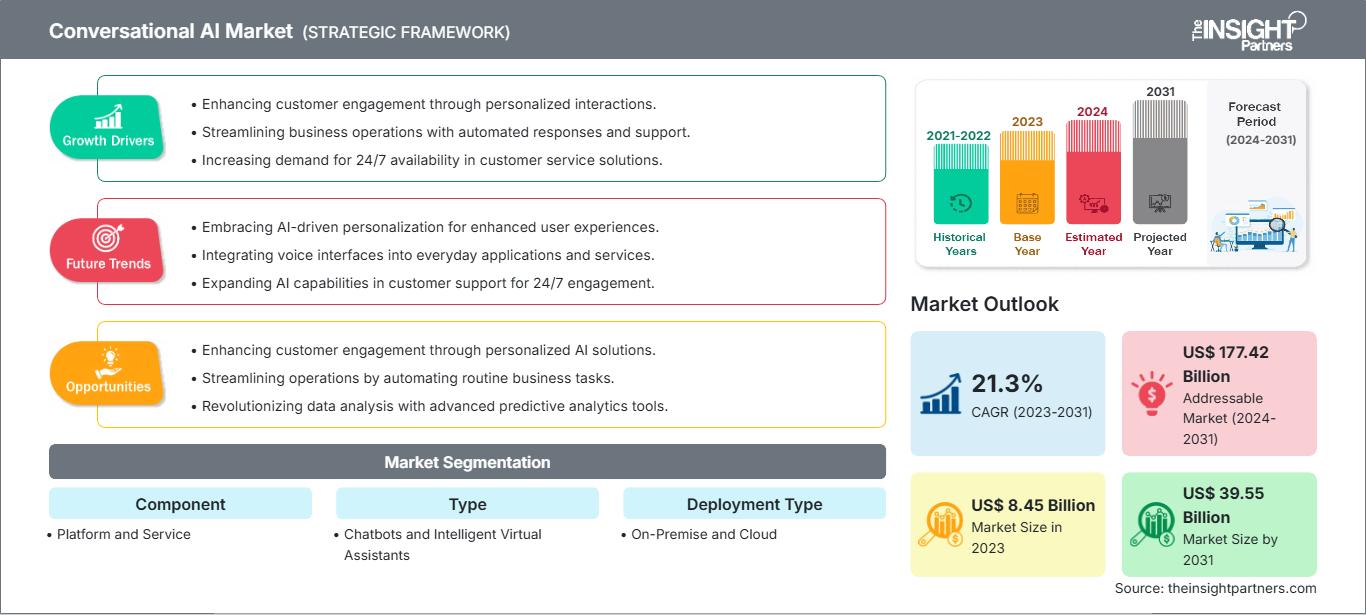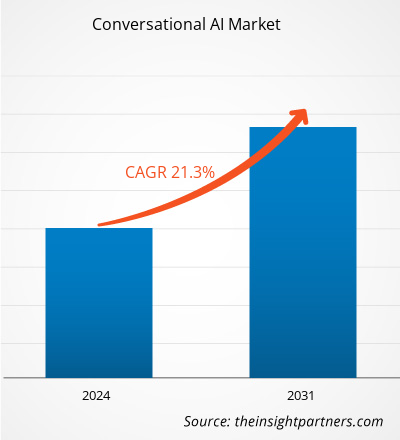Le marché de l'IA conversationnelle devrait atteindre 39,55 milliards de dollars d'ici 2031, contre 8,45 milliards de dollars en 2023. Le marché devrait enregistrer un TCAC de 21,3 % entre 2023 et 2031. L'adoption croissante de l'IA conversationnelle dans l'industrie du jeu vidéo devrait rester une tendance clé du marché au cours de la période de prévision.
Analyse du marché de l'IA conversationnelle
La demande croissante et la baisse des coûts de développement des chatbots, les services d'assistance client basés sur l'IA et le déploiement omnicanal stimulent la croissance du marché de l'IA conversationnelle. De nombreux projets de développement sont en cours pour garantir que ces technologies soient utilisées de manière efficace et efficiente pour les cas d'utilisation en entreprise qui répondent à des problèmes commerciaux réels. Afin d'exploiter la capacité de l'IA à répondre de manière conversationnelle comme un humain, plusieurs entreprises d'IA génératrice ont vu le jour. Elle a le potentiel de transformer radicalement la façon dont les gens interagissent avec la technologie en facilitant des conversations plus informelles, plus humaines, adaptées aux besoins et aux préférences de chacun. De plus, l'utilisation de plateformes d'IA conversationnelle gagne en popularité au sein des organisations du secteur public, les gouvernements du monde entier s'efforçant de permettre une transformation numérique généralisée et de réinventer l'expérience citoyenne, stimulant ainsi la croissance du marché.
Aperçu du marché de l'IA conversationnelle
L'intelligence artificielle (IA) conversationnelle désigne les technologies avec lesquelles les consommateurs peuvent interagir, telles que les chatbots ou les agents virtuels. Elles imitent les interactions humaines en identifiant les entrées vocales et textuelles, en traduisant leur signification en plusieurs langues et en utilisant d'importants volumes de données, l'apprentissage automatique (ML) et le traitement automatique du langage naturel (TALN). L'IA conversationnelle combine les techniques du TALN et du TALN avec des technologies interactives statiques traditionnelles telles que les chatbots. Grâce à des interactions similaires à celles des agents humains classiques, cette combinaison est utilisée pour répondre aux consommateurs.
Personnalisez ce rapport en fonction de vos besoins
Vous bénéficierez d’une personnalisation sur n’importe quel rapport - gratuitement - y compris des parties de ce rapport, ou une analyse au niveau du pays, un pack de données Excel, ainsi que de profiter d’offres exceptionnelles et de réductions pour les start-ups et les universités
Marché de l'IA conversationnelle: Perspectives stratégiques

- Obtenez les principales tendances clés du marché de ce rapport.Cet échantillon GRATUIT comprendra une analyse de données, allant des tendances du marché aux estimations et prévisions.
Vous bénéficierez d’une personnalisation sur n’importe quel rapport - gratuitement - y compris des parties de ce rapport, ou une analyse au niveau du pays, un pack de données Excel, ainsi que de profiter d’offres exceptionnelles et de réductions pour les start-ups et les universités
Marché de l'IA conversationnelle: Perspectives stratégiques

- Obtenez les principales tendances clés du marché de ce rapport.Cet échantillon GRATUIT comprendra une analyse de données, allant des tendances du marché aux estimations et prévisions.
Moteurs et opportunités du marché de l'IA conversationnelle
La croissance du secteur du commerce électronique stimule le marché de l'IA conversationnelle
Depuis la pandémie de COVID-19, on constate une forte augmentation des achats en ligne dans le monde entier. Selon l'Association du transport aérien international (IATA), en 2021, 2,14 milliards de personnes (soit 27,6 % de la population mondiale) ont acheté des produits sur des portails en ligne. De plus, la région APAC est en tête du marché mondial du commerce électronique, la Chine représentant un pourcentage important de la croissance du marché régional. Selon l'Administration du commerce international, la Chine est le plus grand marché du commerce électronique au monde, générant 50 % des transactions mondiales. En 2021, le pays a généré 1 500 milliards de dollars de revenus grâce au secteur du commerce électronique, devenant ainsi le plus grand marché du commerce électronique au monde. L'Europe est également une région clé pour la croissance du e-commerce. Selon Eurostat, en 2022, 91 % des personnes âgées de 16 à 74 ans dans les pays de l'Union européenne (UE) utilisaient Internet, et 75 % d'entre elles commandaient des biens ou des services en ligne. Par ailleurs, la proportion d'acheteurs en ligne est passée de 55 % en 2012 à 75 % en 2022, soit une augmentation de 20 % au cours de la dernière décennie. De nombreux acheteurs européens privilégient les plateformes d'achat en ligne telles qu'Amazon, Target et Walmart, qui stimulent considérablement la croissance du secteur du e-commerce en Europe. La demande croissante d'achats en ligne accroît la demande de commerce conversationnel. Les robots d'achat intelligents, alimentés par l'IA, révolutionnent le secteur du e-commerce en interagissant avec leurs clients, en leur fournissant des conseils personnalisés et en stimulant les ventes. De plus, en s'appuyant sur l'apprentissage automatique et le traitement du langage naturel, l'IA conversationnelle permet d'engager des dialogues constructifs, de comprendre les besoins des clients et d'entretenir des relations clients en temps réel. Ainsi, le secteur en pleine croissance du e-commerce propulse la croissance du marché de l'IA conversationnelle.
L'émergence de l'IA générative offrira des opportunités de marché pendant la période de prévision
L'IA générative est extrêmement importante pour un large éventail d'entreprises. Sa capacité à générer du contenu unique a des répercussions importantes dans des secteurs tels que l'art, le design et le marketing. Cette technologie améliore la personnalisation, innove et rationalise les processus créatifs. De plus, en produisant différents scénarios et réponses, l'IA générative facilite la résolution de problèmes. Elle s'impose ainsi comme un outil clé qui transforme les méthodologies conventionnelles et ouvre de nouvelles perspectives, alors que les industries cherchent à exploiter le potentiel de l'innovation pilotée par l'IA. De plus, l'IA générative excelle dans l'automatisation des activités répétitives, libérant ainsi des ressources humaines pour des projets plus stratégiques et complexes. Elle offre également des expériences hautement personnalisées en fournissant des informations produits adaptées aux goûts de chacun. Des campagnes marketing sur mesure aux suggestions de produits personnalisées, la technologie d'IA générative utilise les données pour produire du contenu qui communique avec chaque utilisateur. L'intégration de l'IA générative aux chatbots conversationnels et aux assistants virtuels améliore leur capacité à participer à des conversations naturelles, comparables à celles des humains. Ces systèmes interprètent et traitent les entrées des utilisateurs pour produire des réponses, des suggestions et des solutions en temps réel. L'IA générative permet aux chatbots de fournir des conseils personnalisés et de gérer les demandes complexes. Cela transforme le service client, les interactions e-commerce et d'autres domaines où une communication efficace est essentielle. De plus, l'IA générative transforme le traitement du langage, permettant des traductions précises et des interactions naturelles qui transcendent les frontières de la communication traditionnelle. Ses applications dans la traduction et les interactions avec les chatbots démontrent la puissance révolutionnaire de l'IA de pointe dans un large éventail de secteurs. Ainsi, l'émergence de l'IA générative devrait alimenter la croissance du marché de l'IA conversationnelle au cours de la période de prévision.
Analyse de segmentation du rapport sur le marché de l'IA conversationnelle
Les principaux segments qui ont contribué à l'élaboration de l'analyse du marché de l'IA conversationnelle sont le composant, le type, le type de déploiement et le secteur d'activité.
- En fonction du composant, le marché est divisé en plateforme et service. Le segment plateforme a dominé le marché en 2023.
- En fonction du type, le marché est segmenté en chatbots et assistants virtuels intelligents. Le segment des chatbots a dominé le marché en 2023.
- En termes de type de déploiement, le marché de l'IA conversationnelle est segmenté en sur site et cloud. Le segment sur site a dominé le marché en 2023.
- En fonction du secteur d'activité, le marché est segmenté en vente au détail et commerce électronique, santé et sciences de la vie, voyages et hôtellerie, BFSI, informatique et Télécommunications, médias et divertissement, et autres. Le segment de la vente au détail et du commerce électronique a dominé le marché en 2023.
Analyse des parts de marché de l'IA conversationnelle par zone géographique
- Le marché de l'IA conversationnelle est segmenté en cinq grandes régions : l'Amérique du Nord, l'Europe, l'Asie-Pacifique (APAC), le Moyen-Orient et l'Afrique (MEA) et l'Amérique du Sud et centrale. L'Amérique du Nord a dominé le marché en 2023, suivie de l'Europe et de l'APAC.
- L'Amérique du Nord détenait la plus grande part de marché en 2023. Le marché de la région connaît une croissance robuste en raison de l'adoption généralisée de technologies innovantes et du besoin croissant de services d'assistance client basés sur l'IA. De plus, la majorité des entreprises nord-américaines investissent dans des innovations technologiques pour répondre aux besoins de leur clientèle, voire les dépasser. La sensibilisation accrue de la population aux questions de santé stimule également la croissance du marché de l'IA conversationnelle dans la région. Le secteur de la santé en Amérique du Nord est à l'avant-garde de l'intégration de la robotique, de l'IA, de la réalité virtuelle (RV) et de la réalité augmentée (RA).
IA conversationnelleAperçu régional du marché de l'IA conversationnelle
Les tendances régionales et les facteurs influençant le marché de l'IA conversationnelle tout au long de la période de prévision ont été analysés en détail par les analystes de The Insight Partners. Cette section aborde également les segments et la géographie du marché de l'IA conversationnelle en Amérique du Nord, en Europe, en Asie-Pacifique, au Moyen-Orient et en Afrique, ainsi qu'en Amérique du Sud et en Amérique centrale.
Portée du rapport sur le marché de l'IA conversationnelle
| Attribut de rapport | Détails |
|---|---|
| Taille du marché en 2023 | US$ 8.45 Billion |
| Taille du marché par 2031 | US$ 39.55 Billion |
| TCAC mondial (2023 - 2031) | 21.3% |
| Données historiques | 2021-2022 |
| Période de prévision | 2024-2031 |
| Segments couverts |
By Composant
|
| Régions et pays couverts | Amérique du Nord
|
| Leaders du marché et profils d'entreprises clés |
|
Densité des acteurs du marché de l'IA conversationnelle : comprendre son impact sur la dynamique des entreprises
Le marché de l'IA conversationnelle connaît une croissance rapide, portée par une demande croissante des utilisateurs finaux, due à des facteurs tels que l'évolution des préférences des consommateurs, les avancées technologiques et une meilleure connaissance des avantages du produit. Face à cette demande croissante, les entreprises élargissent leur offre, innovent pour répondre aux besoins des consommateurs et capitalisent sur les nouvelles tendances, ce qui alimente la croissance du marché.

- Obtenez le Marché de l'IA conversationnelle Aperçu des principaux acteurs clés
- Analyse historique (2 ans), année de base, prévision (7 ans) avec TCAC
- Analyse PEST et SWOT
- Taille du marché Valeur / Volume - Mondial, Régional, Pays
- Industrie et paysage concurrentiel
- Ensemble de données Excel
Rapports récents
Rapports connexes
Témoignages
Raison d'acheter
- Prise de décision éclairée
- Compréhension de la dynamique du marché
- Analyse concurrentielle
- Connaissances clients
- Prévisions de marché
- Atténuation des risques
- Planification stratégique
- Justification des investissements
- Identification des marchés émergents
- Amélioration des stratégies marketing
- Amélioration de l'efficacité opérationnelle
- Alignement sur les tendances réglementaires




















 Obtenez un échantillon gratuit pour - Marché de l'IA conversationnelle
Obtenez un échantillon gratuit pour - Marché de l'IA conversationnelle